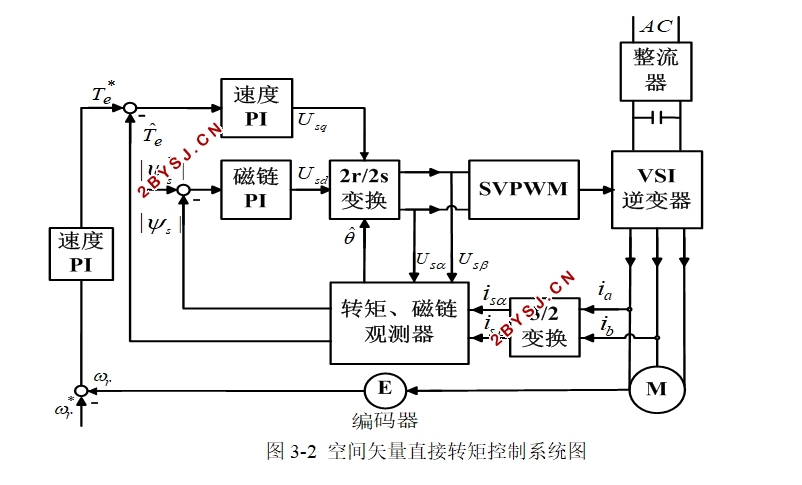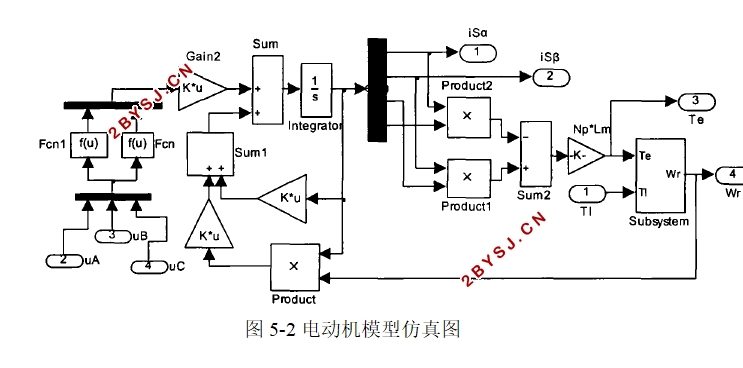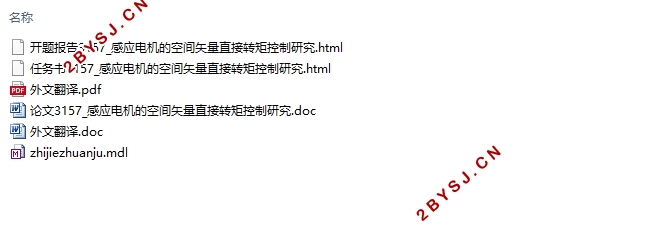感应电机的空间矢量直接转矩控制研究
无需注册登录,支付后按照提示操作即可获取该资料.
感应电机的空间矢量直接转矩控制研究(任务书,开题报告,外文翻译,论文16000字,Matlab模型)
摘要
直接转矩控制技术是继矢量控制技术之后交流调速领域中新兴的控制技术,采用空间矢量的分析方法,在定子坐标系下计算并控制转矩和磁链,以获得转矩的高动态性能,相比于矢量控制,它省去了复杂的矢量变换,克服了对电机转子参数的依赖性,具有转矩响应快的优点。在MATLAB/SIMULINK仿真工具箱中搭建仿真模型,通过设置合理的仿真参数电机参数给定量参数以及PI控制器的控制参数对系统进行仿真研究,从而在理论上验证系统设计的正确性,仿真实验结果证明了这种基于空间矢量脉宽调制的直接转矩控制方法可以有效改善直接转矩控制系统的性能,减小传统直接转矩控制中的磁链和转矩脉动,并使逆变器工作在恒定的开关频率,最后总结论文所做的研究工作,并展望了今后的研究重点和方向。
关键词:感应电机;直接转矩控制;空间矢量调制;MATLAB仿真
A Research For Space Vector Modulation Direct Torque Control Of Induction Motor Drives
ABSTRACT
Direct Torque Control,following the vector control technique, is an emerging technique in the field of AC Motors speed control .Using the space vector analysis method, the DTC technique calculates and controls the torque and flux linkage in the stator coordinate system in order to obtain higher dynamic torque performance. Comparison of vector control DTC eliminates the need of complex vector transform, overcome the dependency to rotor parameters,and has an advantage of fast torque response. Simulation model built in MATLAB/SIMULINK toolbox, by setting a reasonable quantitative parameters and simulation parameters of motor parameters to control the parameters of PI controller for system simulation study, which verifies the correctness of the system design in theory, the simulation results proved that this kind of based on space vector pulse width modulation) direct torque control method can effectively improve the performance of direct torque control system, reduce the traditional direct torque control of flux and torque ripple, and make the inverter work in constant switch frequency, finally summarizes the thesis research work, and predicts the future research emphasis and direction.
KEY WORDS: Induction motor; Direct torque control; SVPWM; MATLAB simulation




目录
摘要 I
ABSTRACT II
目录 III
第一章 绪论 1
1.1 交流电动机控制技术的发展 1
1.1.1 矢量控制 1
1.1.2 直接转矩控制 1
1.2 课题研究的现状 2
1.2.1 直接转矩控制发展现状 2
1.2.2 基于空间矢量调制技术的直接转矩控制发展现状 3
1.3 课题研究的目的和意义 3
1.4 本文研究的主要内容和章节安排 3
第二章 感应电机的数学模型 5
2.1 三相--两相静止变换(α、β、0变换) 6
2.2 两相—两相旋转变换(d、q、0变换) 7
第三章 直接转矩控制的基本原理和系统结构 8
3.1 直接转矩控制基本原理 8
3.2 空间矢量直接转矩控制系统结构 8
3.3 空间矢量基本原理及实现 10
3.3.1 空间电压矢量的工作原理 11
3.3.2 SVPWM的控制算法的实现 13
第四章 直接转矩控制系统的建模 17
4.1电机模型的坐标变换 17
4.2异步电机数学模型的建立 18
4.2.1异步电动机原始动态的数学模型 19
4.2.2电磁转矩模型 19
第五章 仿真和实验结果分析 26
5.1MATLAB介绍 26
5.2控制系统的仿真模型建立 26
5.2.1异步电动机仿真模型图 27
5.2.2 SVPWM模块 28
5.2.3 PI控制器的设计 29
5.3系统仿真结果及分析 31
5.3.1转速阶跃状态 31
5.3.2转矩阶跃状态 33
5.3.3低速下转矩阶跃状态 35
第六章 全文总结与展望 38
6.1 全文总结 38
6.2 展望 39
参考文献 40
